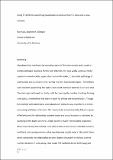Using RT qPCR for quantifying Mycobacteria marinum from in vitro and in vivo samples
Date
2018Metadata
Show full item recordAbstract
Mycobacterium marinum, the causative agent of fish tuberculosis, is rarely a human pathogen causing a chronic skin infection. It is now wildely used as a model system in animal models, especially in zebra fish model, to study the pathology of tuberculosis and as a means of screening new anti-tuberculosis agent. To facilitate such research, quantifying the viable count of M. marinum bacteria is a crucial step. The main approach used currently is still by counting the number of colony forming units (cfu), a method that has been in place for almost 100 years. Though this method well established, understood and relatively easy to perform, it is time-consuming and labor-intensive. The result can be compromised by failure to grow effectively and the relationship between count and actual numbers is confused by clumping of the bacteria where a single colony is made from multiple organisms. More importantly, this method is not able to detect live but not cultivable bacteria, and there is increasing evidence that mycobacteria readily enter a "dormant" state which confounds the relationship between bacterial number in the host and the number detected in a cfu assay. DNA based PCR methods detect both living and dead organisms but here we describe a method, which utilizes species specific Taq-Man assay and RT-qPCR technology for quantifying the viable M. marinum bacterial load by detecting 16S ribosomal RNA (16S rRNA).
Citation
Xaio , H & Gillespie , S H 2018 , Using RT qPCR for quantifying Mycobacteria marinum from in vitro and in vivo samples . in S Gillespie (ed.) , Antibiotic Resistance Protocols . Methods in Molecular Biology , vol. 1736 , Humana Press/Springer , New York, NY , pp. 137-145 . https://doi.org/10.1007/978-1-4939-7638-6_13
Publication
Antibiotic Resistance Protocols
ISSN
1064-3745Type
Book item
Collections
Items in the St Andrews Research Repository are protected by copyright, with all rights reserved, unless otherwise indicated.

